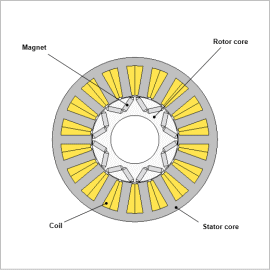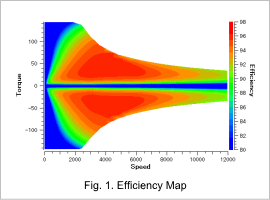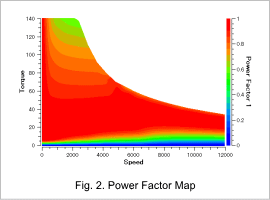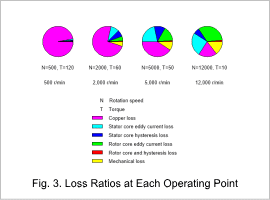*Please prepare a license ID and password for the license administrator.
*It is different from the service for JMAG WEB MEMBER (free membership). Please be careful.
Overview

For traction motor, multi-phase design is sometimes employed with the objective of improving redundancy and reducing torque ripple during drive. multi-phase design includes the likes of 6-phase drive using two inverters. Efficiency maps are created for both motor design and control design in order to fully comprehend the characteristics of motors such as Traction motors that are capable of drive within such a wide range.
Torque, voltage, and current can be calculated from motor voltage equations and torque equations for estimating efficiency, but there exists the issue of difficulty in estimating iron loss, as well as accounting for the nonlinear magnetization characteristics of the iron core. Through simulations using FEA, however, efficiency maps that account for the effects of iron loss and nonlinear magnetization characteristics can be obtained with ease.
In this example, the efficiency map of a 6-phase IPM motor is created with loss ratios at each operating point also evaluated.
Torque, voltage, and current can be calculated from motor voltage equations and torque equations for estimating efficiency, but there exists the issue of difficulty in estimating iron loss, as well as accounting for the nonlinear magnetization characteristics of the iron core. Through simulations using FEA, however, efficiency maps that account for the effects of iron loss and nonlinear magnetization characteristics can be obtained with ease.
In this example, the efficiency map of a 6-phase IPM motor is created with loss ratios at each operating point also evaluated.
Efficiency Map and Power Factor Map
The efficiency map is displayed in Fig. 1, and the power factor map is displayed in Fig. 2.
Motor mode and generator mode efficiency can be understood from Fig. 1. It can be seen that the high-efficiency region for this motor on the motor mode extends to the high-speed area on the generator mode.
For this motor, it can be understood from Fig. 2 that the ratio of reactive power becomes larger at a low rotation speed in high-torque regions, and the ratio of reactive power becomes smaller in low-torque regions.


Loss Ratios at Each Operating Point

Fig. 3 displays pie charts showing loss ratios at low speed and high load, low speed and medium load, medium speed and medium load, and lastly, high speed and low load.
Copper loss decreases in accordance with load. It can be seen that the loss of both the stator core and the rotor core increases in accordance with rotation speed, with eddy current loss increasing in particular.
Copper loss decreases in accordance with load. It can be seen that the loss of both the stator core and the rotor core increases in accordance with rotation speed, with eddy current loss increasing in particular.


